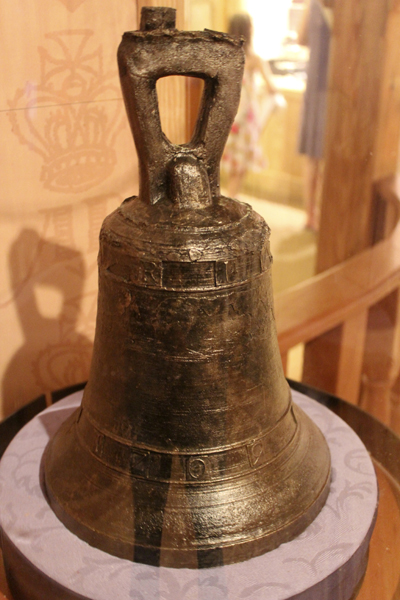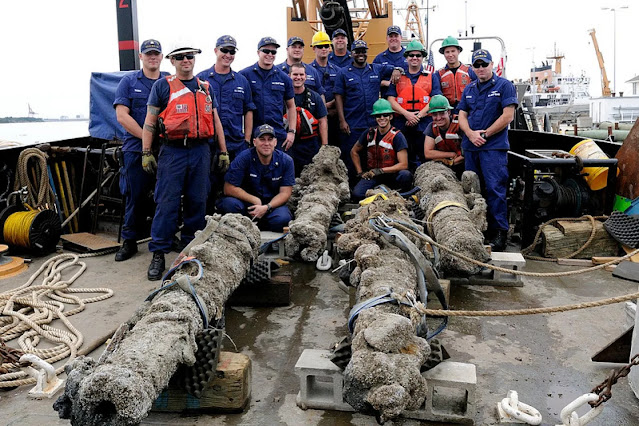Analysis of Shipwreck 31CR314: Was the Queen Ann's Revenge Really Discovered?
Source: allthatsinteresting.com
In the book X Marks the Spot, two chapters discuss shipwreck 31CR314.
This article is an analysis based on the evidence of the two.
Chapter Nine
Archaeologists examine the findings and possibly the remains of Queen Anne’s Revenge. Blackbeard’s activities were in North Carolina and the route he most likely sailed. From there, as recorded, the details of the bloody battle of Lieutenant Maynard and Blackbeard on the morning of November 22, 1718, ultimately led to the pirate's defeat.
In the fall of 1996, Mike Daniel surveyed the inlet's entrance channel and outer bar. The artifacts recovered included a brass blunderbuss barrel, cannonballs, and a bronze bell dating 1705. Out of two hundred shipwrecks, eight of them may be considered the Queen Anne’s Revenge. During the investigation, there were three objectives. First, having an array of specialists was necessary, which turned into an archaeological dream team. The second was getting an understanding of the layout and environmental conditions. And third, to investigate the key elements to identify with Blackbeard’s flagship.
The shipwrecks recorded included the Queen Anne’s Revenge which carried thirty-six to forty guns and was two hundred to three hundred tons; the Adventure, which carried eight to ten guns and eighty tons; and El Salvador, which held eight guns and was one hundred ten tons. The other ships that were lost carried no guns. Three large anchors, two hundred fifty to three hundred fifty tons, were too large for the Adventure, El Salvador, or others. Nothing conclusive to identify 31CR314 as Blackbeard’s ship or to rule it out of this five-week project.
From September 14 to October 16, 1998, there were five hundred-seven hours and twenty-five minutes of recorded diving time. Planks found were positively identified as European red pine. Recovered artifacts were most likely from the officers’ quarters, and a fourth anchor was discovered. The artifact was nearly identical to the Whydah pirate ship. Additionally, samples of gold dust discovered were not typically found in the area. Finally, eighteen cannons, two out of three, were loaded, which exhibits more evidence of Queen Anne’s Revenge.
Chapter nine explains the various instruments used to support this evidence. Geologists created twenty-five digital maps surveying the Beaufort Inlet from the 1700s to the present. Estimates show the shipwreck was buried eighty percent of the time. Also, explaining how now, in twenty feet of water, at the time of the wreckage, it was only ten to twelve feet deep.
Marine geologists used high-resolution bathymetric and side scan sonar to survey; only two existed in the United States. Archaeologists used remote sensing instruments, including magnetometers and magnetic gradiometers. Returning in the fall of 1999, The Surface Interval Dive Company recorded two thousand sixty-four readings. Two more small cannons were found, one from England, and one from Sweden, now a total of twenty-one cannons. September 25 to October 13, 2000, was the final major expedition where one hundred eighty-four artifacts were found. The following spring, another cannon was found.
This ship was originally a French slave ship named the Concorde that was presumably overtaken by Blackbeard in late 1717; he increased the number of guns to forty and renamed it Queen Anne’s Revenge. Blackbeard continued to capture many ships, including the Protestant and Adventure. While sailing through Topsail Inlet, the Queen Anne’s Revenge and the Adventure was reported grounded on the outer bar. He sailed off in a smaller ship and received a king’s pardon at the colonial capital of Bath. For the next few months, Blackbeard continued a piratical spree and, in the end, faced Royal Navy lieutenant Robert Maynard in his ultimate defeat in 1718.

In 1996, during a magnetometer survey, treasure hunters were reported to have taken thirty artifacts, including a dated bronze bell, stamped musketoon barrel, and inscribed-sounding lead. 1997 was predominately a post-disturbance survey and mapping that discovered the main ballast pile, three anchors, fifteen cannons, and three hundred thirty-three small artifacts. 1998, is marked as a continual assessment. In addition to ballast stones, barrel hoops, deadeyes, and lead shots, three additional cannons were found, four hundred nine artifacts total.
In June and October 1999, archaeologists conducted a diver-positioned magnetometer survey. Two more cannons were found, along with forty-eight related and fifty-one small artifacts. The 2000 field season retrieved a section of the wooden hull and 117 artifacts. Over two thousand artifacts total were recovered since November 1996.
The chapter supports facts of the bronze bell found with HIS MARIA and ANO DE 1709 inscribed, which marks the sign of Spanish or Portuguese origin. Two lead pump sieves were recovered, resembling the ones found on El Nuevo Constante, wrecked in 1766. Anchor stocks were made of white oak and tropical bloodwood.
Both chapters support detailed facts on the artifacts discovered. Chapter nine goes into more of the weather conditions and an archaeologist's journey during this excavation. As much as I would love to believe the supporting evidence of this shipwreck being Queen Anne’s Revenge, the details, in my opinion, don’t match up. For example, chapter nine explained that the wreck could only be a handful of possible ships recorded to disappear in the area and could not be a merchant ship. Still, chapter ten explains that many merchant ships carried efficiently around twenty guns. The Queen Anne’s Revenge allegedly had forty guns, and only twenty-two were discovered in the site area.
Another supporting fact is that the only French-made artifact was a pewter syringe on a supposed French slave ship that should exhibit some evidence of slave trading goods. However, the bell found on the ship was Spanish and most likely not transferred from another vessel, not to mention the date on the bell, 1709, does not match up with the building date of the missing vessel.
Lusardi, W. R. (2007). The Beaufort Inlet Shipwreck Artifact Assemblage, X Marks the Spot: The Archaeology of Piracy (pp.196-218). Gainsville, Florida: University Press of Florida.
Wild-Ramsing, M. U. (2007). The Pirate Ship Queen Anne’s Revenge, X Marks the Spot: The Archaeology of Piracy (pp.160-195). Gainsville, Florida: University Press of Florida.
In the fall of 1996, Mike Daniel surveyed the inlet's entrance channel and outer bar. The artifacts recovered included a brass blunderbuss barrel, cannonballs, and a bronze bell dating 1705. Out of two hundred shipwrecks, eight of them may be considered the Queen Anne’s Revenge. During the investigation, there were three objectives. First, having an array of specialists was necessary, which turned into an archaeological dream team. The second was getting an understanding of the layout and environmental conditions. And third, to investigate the key elements to identify with Blackbeard’s flagship.
The shipwrecks recorded included the Queen Anne’s Revenge which carried thirty-six to forty guns and was two hundred to three hundred tons; the Adventure, which carried eight to ten guns and eighty tons; and El Salvador, which held eight guns and was one hundred ten tons. The other ships that were lost carried no guns. Three large anchors, two hundred fifty to three hundred fifty tons, were too large for the Adventure, El Salvador, or others. Nothing conclusive to identify 31CR314 as Blackbeard’s ship or to rule it out of this five-week project.
From September 14 to October 16, 1998, there were five hundred-seven hours and twenty-five minutes of recorded diving time. Planks found were positively identified as European red pine. Recovered artifacts were most likely from the officers’ quarters, and a fourth anchor was discovered. The artifact was nearly identical to the Whydah pirate ship. Additionally, samples of gold dust discovered were not typically found in the area. Finally, eighteen cannons, two out of three, were loaded, which exhibits more evidence of Queen Anne’s Revenge.
Chapter nine explains the various instruments used to support this evidence. Geologists created twenty-five digital maps surveying the Beaufort Inlet from the 1700s to the present. Estimates show the shipwreck was buried eighty percent of the time. Also, explaining how now, in twenty feet of water, at the time of the wreckage, it was only ten to twelve feet deep.
Marine geologists used high-resolution bathymetric and side scan sonar to survey; only two existed in the United States. Archaeologists used remote sensing instruments, including magnetometers and magnetic gradiometers. Returning in the fall of 1999, The Surface Interval Dive Company recorded two thousand sixty-four readings. Two more small cannons were found, one from England, and one from Sweden, now a total of twenty-one cannons. September 25 to October 13, 2000, was the final major expedition where one hundred eighty-four artifacts were found. The following spring, another cannon was found.
Source: pirateshipvallarta.com
Chapter Ten

Source: thehistoryblog.com
In June and October 1999, archaeologists conducted a diver-positioned magnetometer survey. Two more cannons were found, along with forty-eight related and fifty-one small artifacts. The 2000 field season retrieved a section of the wooden hull and 117 artifacts. Over two thousand artifacts total were recovered since November 1996.
Analysis
Source: plush-overground.com
Another supporting fact is that the only French-made artifact was a pewter syringe on a supposed French slave ship that should exhibit some evidence of slave trading goods. However, the bell found on the ship was Spanish and most likely not transferred from another vessel, not to mention the date on the bell, 1709, does not match up with the building date of the missing vessel.
Most of the artifacts found were English, including pewter plates marks “London” and a Tudor Rose, indicative of the time of King Henry Tudor. The surveying instruments recovered were dated post-battle. If this evidence was held in court that this shipwreck was, beyond a reasonable doubt, Queen Anne’s Revenge, it would not hold up, and the case would be thrown out.
A recovered brass musketoon barrel and loaded cannons suggest a battle was most likely a result of the shipwreck. On the other hand, it may have simply been another merchant vessel captured by Blackbeard during his pirate raids and went down in battle against lieutenant Maynard. In any case, as much as I would like to see the dedicated work and research from all the individuals to result in confirmation of locating the lost Queen Anne’s Revenge, I believe the quest should go on.
References
References
Lusardi, W. R. (2007). The Beaufort Inlet Shipwreck Artifact Assemblage, X Marks the Spot: The Archaeology of Piracy (pp.196-218). Gainsville, Florida: University Press of Florida.
Wild-Ramsing, M. U. (2007). The Pirate Ship Queen Anne’s Revenge, X Marks the Spot: The Archaeology of Piracy (pp.160-195). Gainsville, Florida: University Press of Florida.









Comments
Post a Comment